Day of the Dead (Mexico): How to Celebrate Día de Muertos Like a Local
The Day of the Dead or Dia de Muertos is one of the most significant celebrations in Mexican popular culture.
It’s a time to pay tribute to the deceased through a vibrant and colorful celebration, and its significance has even been recognized by UNESCO as it has been designated an Intangible Cultural Heritage of Humanity.
The festival has its roots in pre-Hispanic times, but it has been greatly influenced by Catholic religion over the centuries, turning it into a fine example of the identity syncretism so present in Mexico.
To learn more about the symbolism of the Day of the Dead and to know where and how to attend the celebration, here’s my complete guide on the subject!
So, what is the Day of the Dead celebration like in Mexico?
Sommaire
- Day of the Dead (Mexico): How to Celebrate Día de Muertos Like a Local
- When is the Day of the Dead Celebrated?
- Where and How to Participate in the Day of the Dead?
- Yucatan Peninsula
- Oaxaca
- Mexico City
- The Grand Parade of the Day of the Dead (November 2)
- Grand Illumination of the Day of the Dead (30 oct)
- Grand Offering in the Historic Center (Oct 25 to Nov 3)
- Alebrijes Parade (October 19th)
- Grand Parade of the Catrinas (October 27th)
- Nighttime Event at Chapultepec Park (October 31st to November 3rd)
- Water Show at Xochimilco
- San Andrés Mixquic
- Other Events in Mexico City
- Michoacan
- Other States and Regions
- How is the Day of the Dead Celebrated in Mexico?
- What Makes Up the Altar of the Dead in Mexico?
- My Last Tips for the Day of the Dead
- Rent a car in Mexico
- How to find your airline tickets at the best price?
- You’re traveling in Mexico? These articles will help you!
When is the Day of the Dead Celebrated?
Though some festivities begin as early as the end of October, the Day of the Dead mainly takes place over two days:
- on November 1st, when babies and children who have passed away are celebrated
- on November 2nd to celebrate the adults
Where and How to Participate in the Day of the Dead?
There are tons of festivities for the Day of the Dead throughout Mexico, starting from the end of October until November 2nd.
Here are some of the main activities in Mexico, listed by region:
Yucatan Peninsula
Cancun, Riviera Maya, and Quintana Roo
Even though it’s a very touristy region, the Day of the Dead is not as widely celebrated in the state of Quintana Roo as it is in other places because it’s not part of the local traditions.
However, there have been some events that have popped up in recent years:
- Cancun: Hanal Pixan is celebrated in Puerto Juarez from October 31 (from 4 p.m.) to November 3 with an altar exhibition, a maritime procession, a catrina parade, an altar and catrina competition, handicrafts and more.
- Cancun: there’s also the Hanal Pixan festival at Donceles Park on October 30 (7-11pm) with an altar exhibition (visit at 8pm), gastronomy, a cultural show, a costume contest for kids etc.
- Bacalar: several activities are taking place at the corner of Calle 8 and Avenida 7 in downtown Bacalar, from October 2nd to 4th, 2023
- Cozumel: Las Animas parade on October 26th at 7:30 PM with costumes and candles
- Playa del Carmen: Day of the Dead celebrations at the Plaza Civica (music, altar contests, gastronomy), Todas Somos Catrinas parade (6 PM, October 29th) starting from Plaza Quinta Alegria, and of course, several locations along Quinta Avenida being adorned for the occasion.
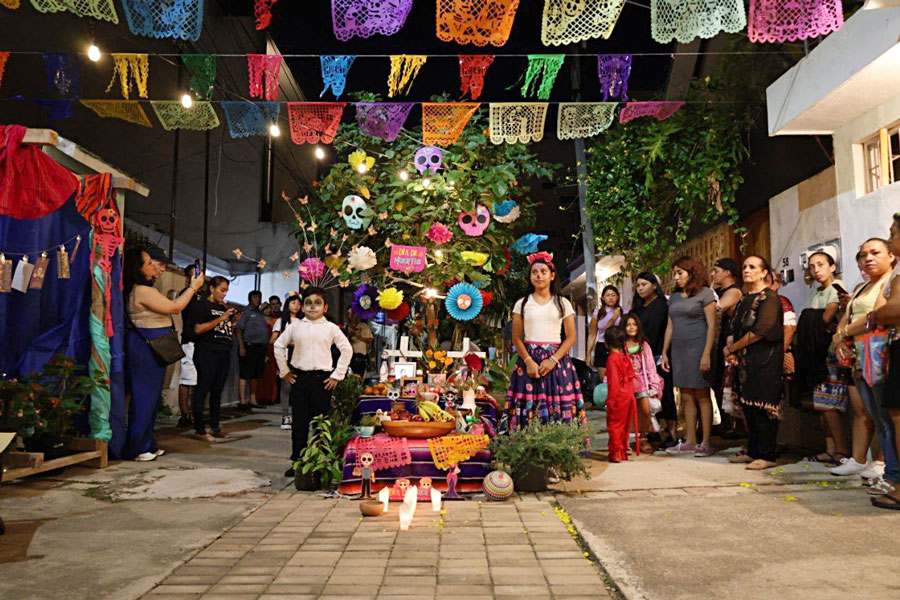
Xcaret (Oct 30-Nov 3)
Xcaret is a park that offers numerous attractions, such as underground rivers, wildlife, performances, and more. You can spend the whole day exploring the park and enjoying its natural beauty!
But for a few days, you can also take part in the beautiful Festival of Life and Death Traditions: it’s the biggest Day of the Dead celebration in the Riviera Maya!
Not only is Xcaret beautifully decorated with Cempasuchil flowers, candles, and numerous altars with offerings, but there are also many activities: traditional dances and music, plays, exhibitions, craft workshops, and more.
Reserve your ticket for the Day of the Dead celebration at Xcaret here, which includes access to the park for the full day + the festival from 4 PM to 10 PM:
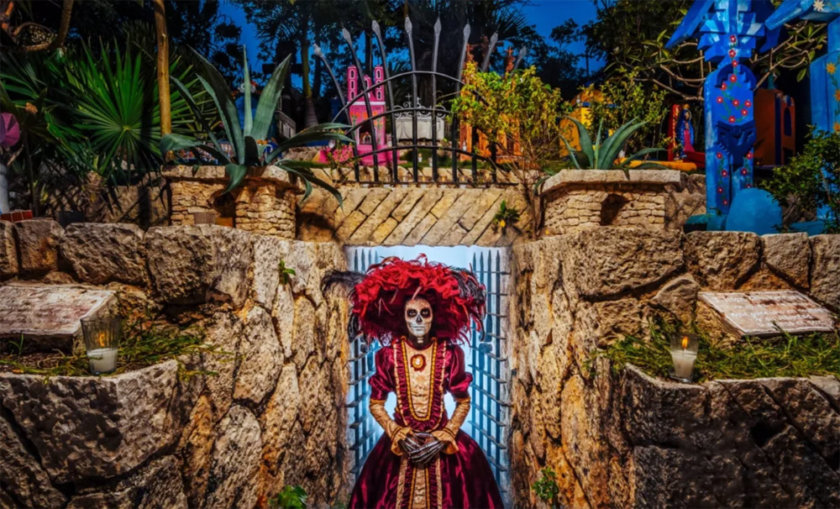
Campeche
Pomuch (October 31)
If you’re looking for a truly unique and unforgettable experience, you should visit Pomuch, a village in Campeche with a singular tradition for the Day of the Dead.
There, you can witness the Choo Ba’ak ritual, which involves cleaning the bones of the deceased and preparing them for the spiritual visit.
This practice is a sign of respect and love for ancestors, who are honored with flowers, candles, and embroidered cloths.
In Pomuch, you can also taste their delicious artisanal bread, baked in stone and wood ovens!
Activities will take place all day on October 31: handicraft market, art exhibition, altar, poetry in Maya, theater, music, a representation of Pok Ta Pok (Mesoamerican ballgame), and more.
To see the schedule of activities, check out the Dia de Muertos Festival’s Facebook page in Pomuch.
City of Campeche
In Campeche, you can admire several stunning altars along Calle 8, between Calle 61 and Calle 61.
- For all the activities during the Day of the Dead in the State of Campeche, visit the Turismo Campeche Facebook page.
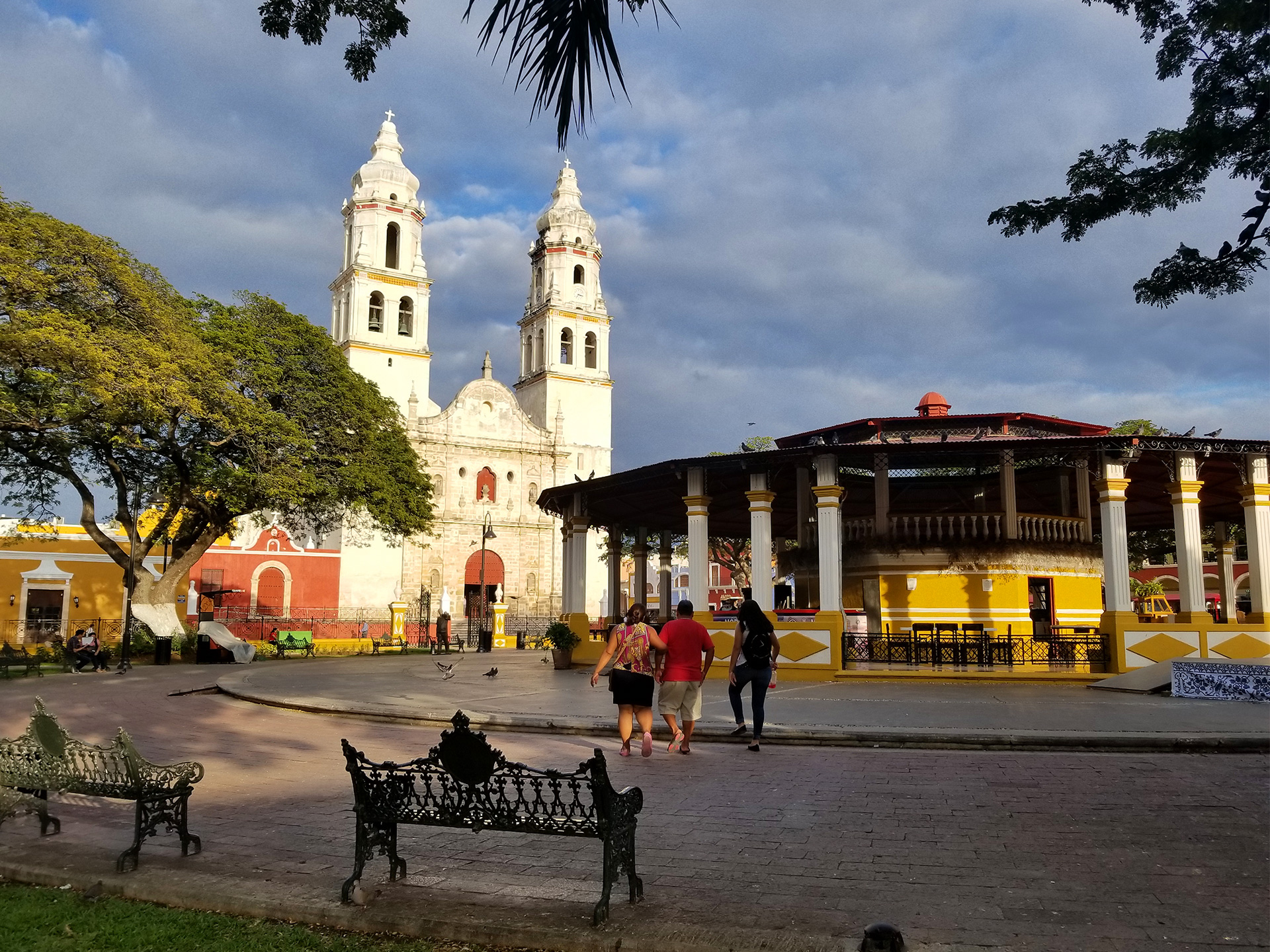
State of Yucatan
The Day of the Dead in Yucatan is called Hanal Pixán, meaning “food for the souls”.
On October 31, departed children (u hanal palal) are celebrated, adults (u hanal nucuch uinicoob) on November 1, and a grand mass is held in the cemetery on November 2 (hanal pixanoob or misa pixán).
In Mérida, activities start as early as October 26, including walking and biking tours, exhibitions, and more. You can check the schedule on the Festival de las Animas website.
Among these, I especially recommend you not to miss:
– the Paseo de las Ánimas, a parade that starts at the General Cemetery and ends at San Juan Park, featuring 500 participants dressed as skeletons and wearing typical Yucatan clothing.
– the breathtaking Dia de Muertos altars on the Plaza Grande, the city’s main square.
– the Catrinas parade concluding with the Noche de las Catrinas, between Paseo Montejo and the Casa de Montejo.
– The Maya ballgame or Pok Ta Pok on the main square
-The Parque San Juan is illuminated, usually from October 21, with figures of catrinas and other characters.
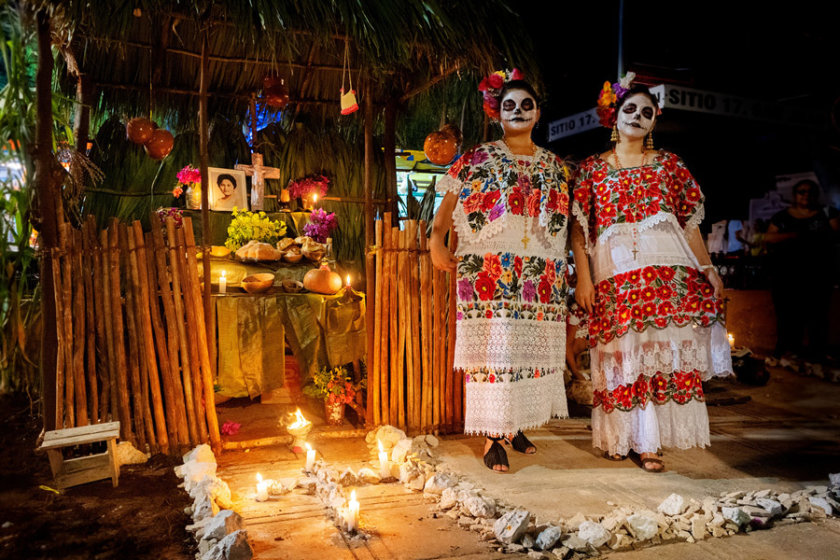
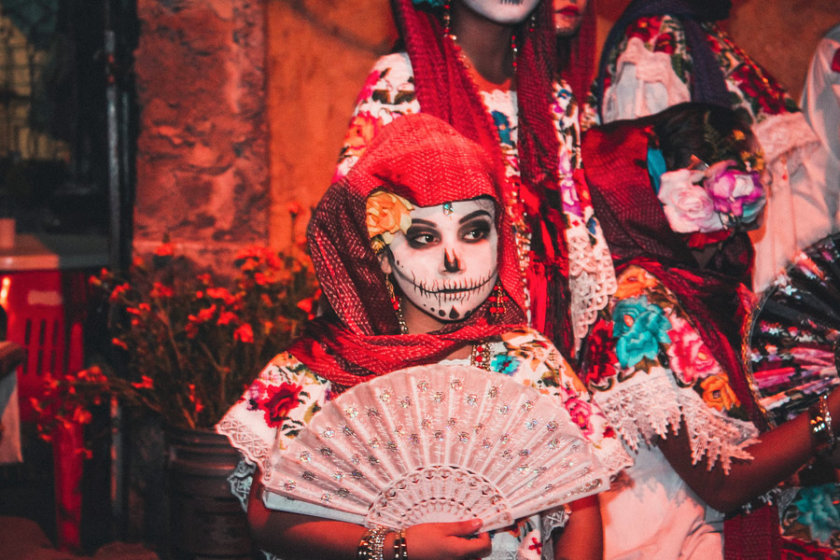
Oaxaca
Oaxaca is known for its festive spirit!
Indeed, vibrant traditions are deeply ingrained here and virtually at any time of the year, there’s a celebration happening in one or more communities.
The Guelaguetza (late July) is the most grandiose festival in the region and one of the most significant in all of Latin America, but the Day of the Dead in Oaxaca is also an enormous, color-saturated celebration lasting the entire week.
For the Day of the Dead in Oaxaca, you’ll find altars of astounding beauty throughout the city, especially on Macedonio Alcalá Street, between the Zocalo and Santo Domingo!
Of course, you should also visit the cemeteries (known as “panteones”), and there’s a multitude worth seeing with music, flowers, mezcal, mole, and hot chocolate!
For example:
– Xochimilco (November 1) and San Felipe (November 2) located within the city.
–Santa Cruz Xoxocotlán, 20 minutes from Oaxaca (October 31): very large, lively, and downright impressive!
–Santa Maria Atzompa, 30 minutes from the city (October 31).
On the Sunday before Day of the Dead, the Muerteada or Comparsa parade kicks off the festivities.
It’s a large parade featuring thousands of participants of all ages in costumes, with dancing, music, and fireworks.
Subsequently, there are splendid parades every day, but I especially recommend the one in San Agustín Etla (35 minutes from Oaxaca), which is highly traditional, or the one in the Jalatlaco district, both occurring on November 1st.
- For all the activities to do and places to stay in Oaxaca, I invite you to read my Ultimate Guide to Oaxaca!
You will explore the history and culture of Oaxaca, from the Church of Santo Domingo and the cemetery, where altars and offerings pay homage to the deceased, to the vibrant Xochimilco neighborhood, where locals share their traditions and zest for life.
The tour concludes with a delicious dinner on the terrace of the Ancestral restaurant, where you can admire the panoramic view of the city illuminated by candles.
This tour is more than just a tourist trip. It’s an educational and cultural experience that will deepen your understanding and appreciation of Oaxaca and its people.
You can easily book it here:
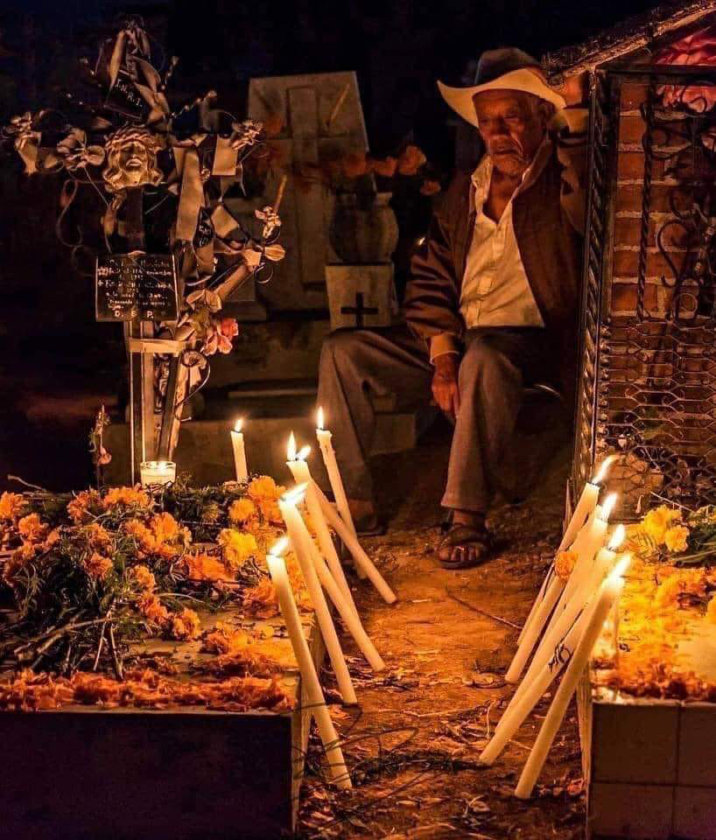
Mexico City
The capital is a vibrant city that hosts a multitude of events throughout the year, and there is much to do and see for the Day of the Dead in Mexico City!
The Grand Parade of the Day of the Dead (November 2)
Have you seen the James Bond film, 007 Spectre (2015)?
At the very start of the film, James Bond is seen moving through the Day of the Dead parade in the historic center of Mexico City.
But in reality, this famous parade didn’t exist before the movie!
It was created the following year by the government, inspired by the film, and instantly became a success.
Today, it’s a must-attend event in Mexico City filled with dancers, allegorical floats, music, acrobats, and costumes that attract a huge number of national and international tourists.
Even if it’s not a traditional activity, it’s a grand celebration of Mexican popular culture and I really recommend attending if you’re there during this time of the year. 😍
- The date and time change every year. In 2024, it will take place on Saturday, November 2, starting at 2pm from Puerta de los Leones towards the Zocalo (3 hours).
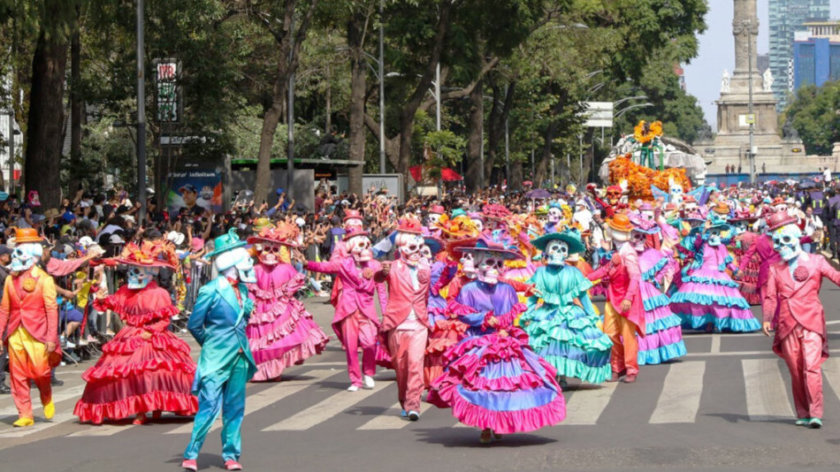
Grand Illumination of the Day of the Dead (30 oct)
Large figures celebrating the Day of the Dead are displayed on the facades of buildings around Mexico City’s main square, the Zócalo—like the Mercaderes Building, the National Palace, and City Hall. And at night, it’s all beautifully lit up!
Grand Offering in the Historic Center (Oct 25 to Nov 3)
The center of Mexico City is one of my favorite places in the capital throughout the year.
No matter how many times I’ve been, there’s always something new to discover. So it’s obvious that it’s the place to be when there is a festival in Mexico. And this year, the grand offering will be made in honor of Pancho Villa!
In addition to the Day of the Dead Parade, don’t miss the Festival of Offerings and Floral Arrangements featuring 27 offerings created by different indigenous communities from the country, as well as those from Guerrero, State of Mexico, Hidalgo, Puebla, Chiapas, Yucatán, and Tlaxcala.
Complementing it all will be colorful sawdust carpets (called tapetes de aserrín) crafted by artisans from Huamantla.
It’s the time to take lots of beautiful photos. 😉
Alebrijes Parade (October 19th)
The alebrijes are fantastical creatures that hold an important place in Mexican folk art.
The Mexico City Folk Art Museum organizes a grand parade that starts from Zocalo at noon and goes all the way to the Angel of Independence, passing along Avenida Reforma, with creations from artists, museums, as well as various public and private institutions.
- These alebrijes will be displayed on Paseo de la Reforma Avenue between the Angel of Independence and the Diana the Huntress Fountain.
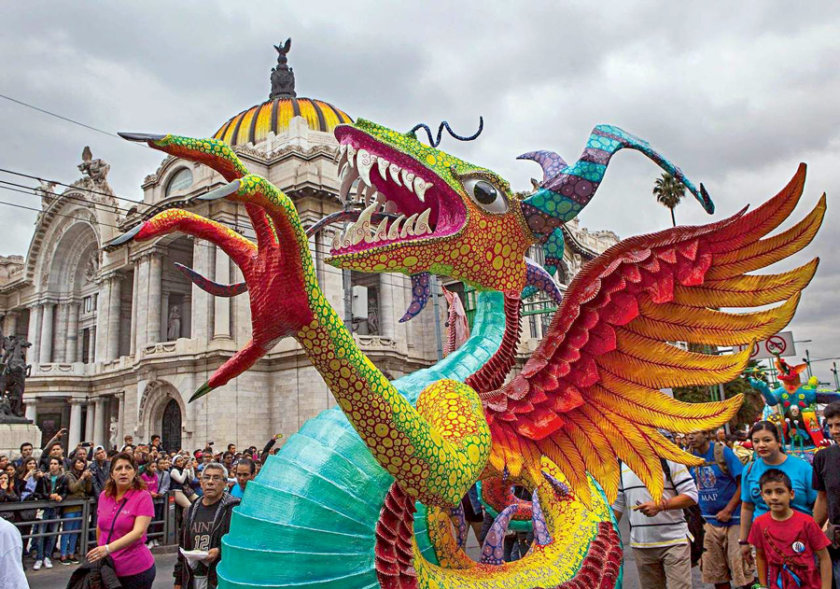
Grand Parade of the Catrinas (October 27th)
The Catrina is the skeletal figure of a woman, elegantly dressed with a French-style hat.
She was created by the illustrator José Guadalupe Posada in the early 20th century, but it was Diego Rivera, the husband of Frida Kahlo, who gave her her current appearance in his famous mural “Sueño de una tarde dominical en la Alameda Central“.
Today, she is an important figure in popular culture seen all over Mexico and is closely associated with the Day of the Dead.
The Grand Parade of the Catrinas starts at 6:30 PM at the Angel of Independence and goes all the way to the Zocalo, passing along Reforma, and features numerous allegorical floats, dancers, actors, and musicians!
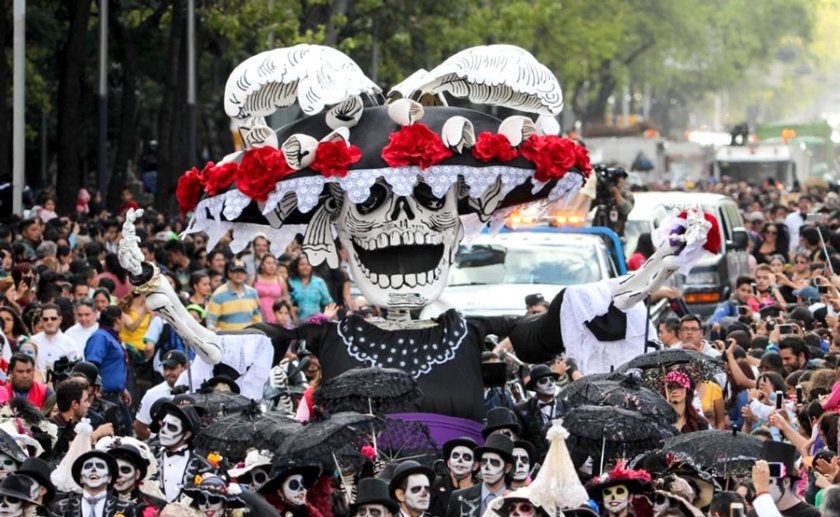
Nighttime Event at Chapultepec Park (October 31st to November 3rd)
From 7 PM to 11 PM, at Chapultepec Park, the Teopankali (meaning “house of altars” in Nahuatl) provides a mystical yet festive nighttime immersion into the world of the Day of the Dead celebration.
The route spans 1.3 km, from the Puerta de los Leones to the Lakeside Terrace, featuring giant skulls, video mapping, and lively music.
There are 12 altars adorned with cempasuchil flowers and various traditional elements from the states of Oaxaca, Guerrero, Michoacan, and Chiapas.
Everyone is invited to bring a photo of a loved one who has passed away to place on one of the 12 altars ❤️
Water Show at Xochimilco
Xochimilco is famous for its myriad of canals best explored aboard a colorful boat.
Every year, it hosts a spectacle combining dance, theater, singing, music, sounds, and lights, based on La Llorona or “The Crying Woman”.
It’s based on a significant Mexican legend that tells of a woman’s spirit wandering in search of her children while letting out terrifying cries of sorrow “¡Ay, mis hijos!”, “Ah, my children!”
The experience begins at the Cuemanco dock where you board a trajinera to navigate the canals until reaching Laguna Tlílac where the stage is located. At night, under the moonlight, the atmosphere is enchanting!
- Performances from early October to late November, from Friday to Sunday
- The boat ride lasts 45 minutes (one way) and the performance is 1 hour long
- Bring warm clothes as it gets chilly, and mosquito repellent
- La Llorona Xochimilco Website
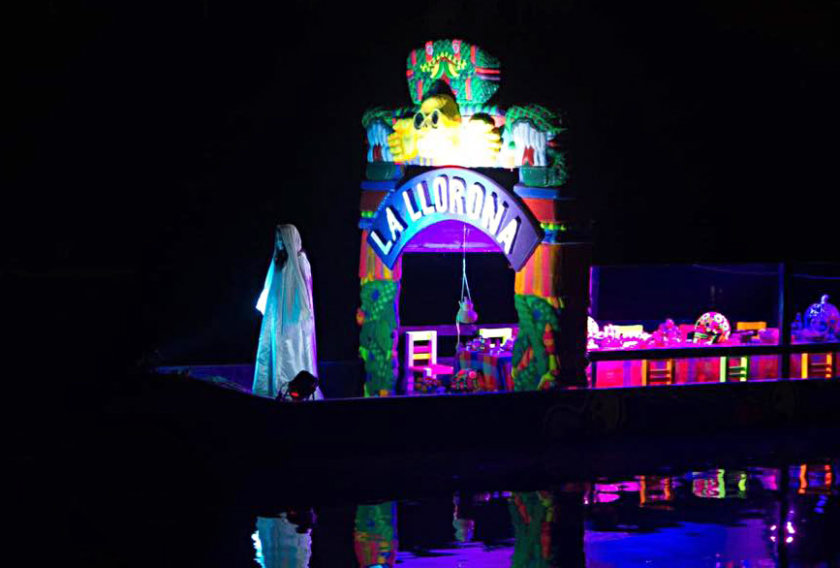
San Andrés Mixquic
Located about an hour and a half south of Mexico City’s center, San Andrés Mixquic is one of the oldest and most traditional places in the city.
The capital offers a lot of interesting activities, but there’s no doubt that the most traditional Day of the Dead celebration in Mexico City is in Mixquic, where you can truly feel a mystical atmosphere.
Altars with offerings are set up from October 31st, but the most touching moment occurs on the 2nd of November at 7:00 PM: the “Alumbrada,” when candles are lit on the graves of the deceased, and they are decorated with flowers.
When there, don’t forget to visit the Parish of San Andrés, try the pan de muerto and the many local dishes!
It includes pick-up in Mexico City in a comfortable vehicle, as well as a safe guided tour through the historic center of San Andrés Mixquic and its cemetery, visiting several altars and shrines along the way.
Book the San Andrés Mixquic tour here:
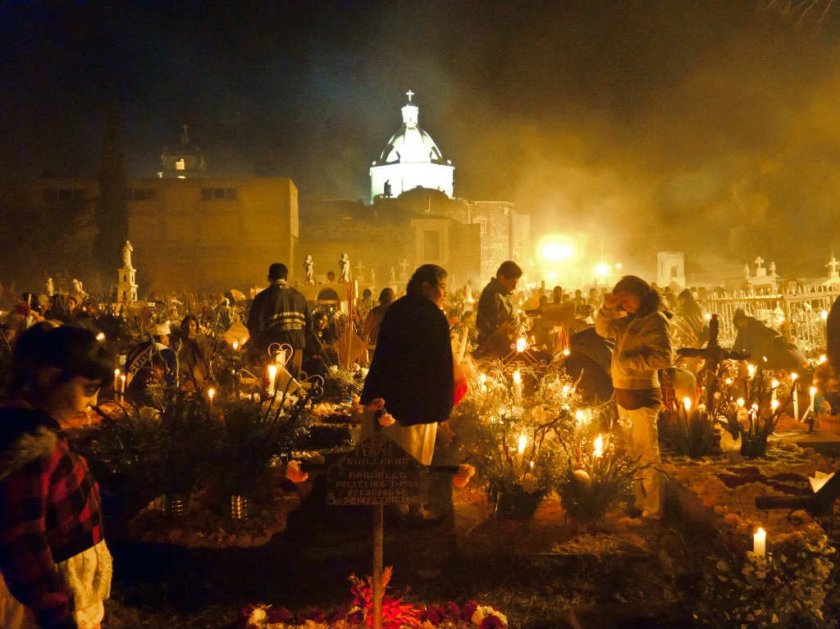
Other Events in Mexico City
There are several other activities and events for the Day of the Dead in Mexico City such as:
- The Artisan Festival of Coffee, Chocolate, and Pan de Muerto: Oct 19-20, from 12 PM to 7 PM, Jalapa 44, Roma Norte (entry 50 pesos)
- The Pan de Muerto and Chocolate Festival in Coyoacán: Oct 26-27, from 11 AM to 7 PM, Centro de Convenciones Churubusco (free entry)
- Camino al Mictlán: Oct 18-19-20, from 10 AM to 6 PM at the Palacio de la Autonomía de la UNAM (free entry, paid cocoa ceremony). This bazaar features cocoa ceremonies, customized catrinas, artistic presentations about Mictlán, mezcal tastings, chocolate, pan de muerto, and much more.
- Coco: inspired by the movie “Coco“, a concert with Mexican artists performing the film’s iconic songs. One performance only on November 2nd at 7 PM (buy your tickets here)
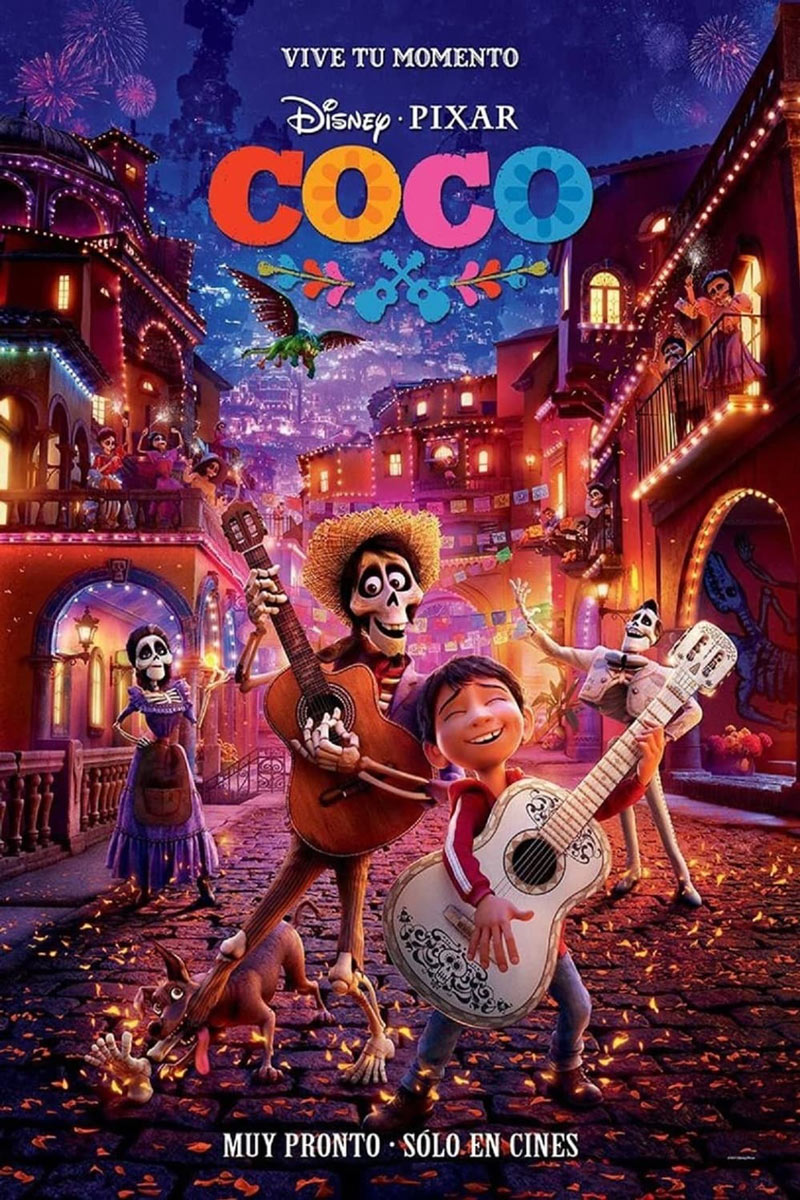
Michoacan
Michoacán is definitely the Mexican State where the tradition of the Day of the Dead is most important and deeply rooted in the local culture.
The main attraction of the Day of the Dead in Michoacan is on Janitzio, an island in the center of the lake of Pátzcuaro reachable only by boat (25 minutes from the docks of San Pedrito, General or Las Garzas).
Here, the cemetery is covered with flowers, candles, and food for the departed, but this beautiful celebration has become very touristy, so expect to share the space with a lot of visitors.
If you prefer a festive but somewhat more intimate setting, I suggest heading to islands, towns, and villages around Lake Patzcuaro like:
- Island of Jarácuaro where you can witness several traditional dances such as the Danza de los Viejitos (“Dance of the Little Old Men”), along with numerous floral arches and the beautiful decorations of the Temple of San Pedro and the Chapel of the Nativity.
- Island of Pacanda: a more alternative, much less touristy option for experiencing the local Day of the Dead celebrations. Accessible by boat (a 15-minute round trip) from Ucasanastacua, with the possibility to stay overnight in the community hotel.
- Arócutin: see the large floral arch in front of the temple of Our Lady of the Nativity and the cemetery covered with candles and cempasúchil flowers.
- Cuanajo: the village is famous for its ketzitakua, the incredible altars that families place at home, featuring little wooden horses. According to their beliefs, the more there are, the more the deceased was loved!
- Tzintzuntzan: there are two cemeteries facing each other, adorned with impressive offerings (crafts, flowers, food, sweets) and lit by a multitude of candles. There are also various cultural activities, including a reenactment of the Purépecha ball game, a game that dates back to pre-Hispanic times!
- Patzcuaro: I absolutely love this charming town in Michoacan for its picturesque landscape, rich culture, and year-round appeal. For the Day of the Dead, the cemetery is filled with offerings, and you can also visit Plaza Vasco de Quiroga to see the best examples of crafts from all the ethnic groups of Michoacan, and enjoy numerous performances and concerts.
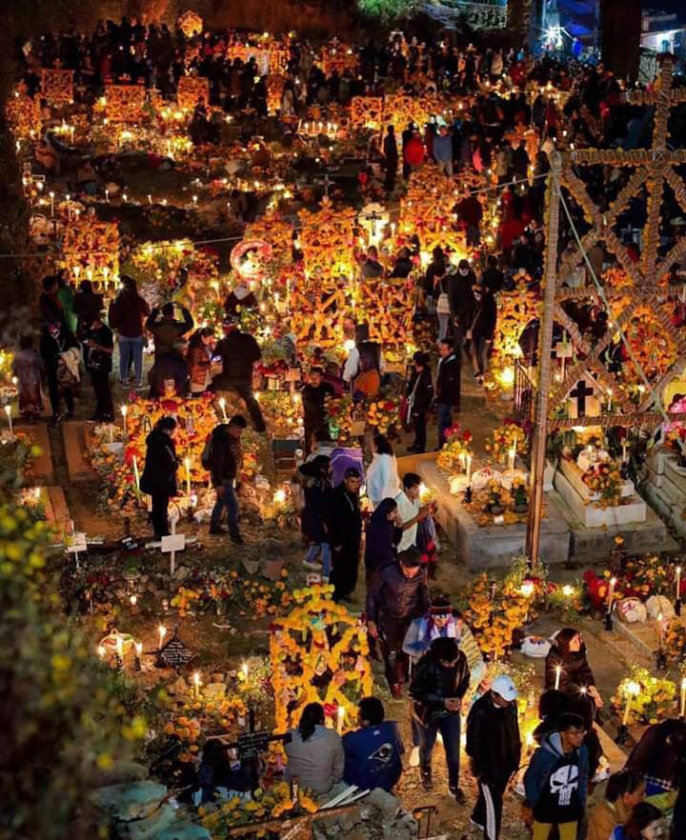
Other States and Regions
Day of the Dead is celebrated in many regions of Mexico and it’s impossible to cover everything in one article!
Here are some other (less known) places that are worth a visit:
Atlixco (Puebla)
Atlixco is a city known for its traditional festivals where the streets are decorated with floral carpets. For Day of the Dead, the municipal esplanade is covered with over 150,000 flowers!
Starting October 28th, various activities such as offerings, visits to the cemetery, and musical concerts are organized.
However, the most anticipated event is the grand Parade of Skulls, taking place on November 2nd, with thousands of people dressed as catrinas, giant catrinas, and mojigangas.
In this parade, you can see important figures from the local culture such as the charro negro, the devil, the nahual, and the witch.
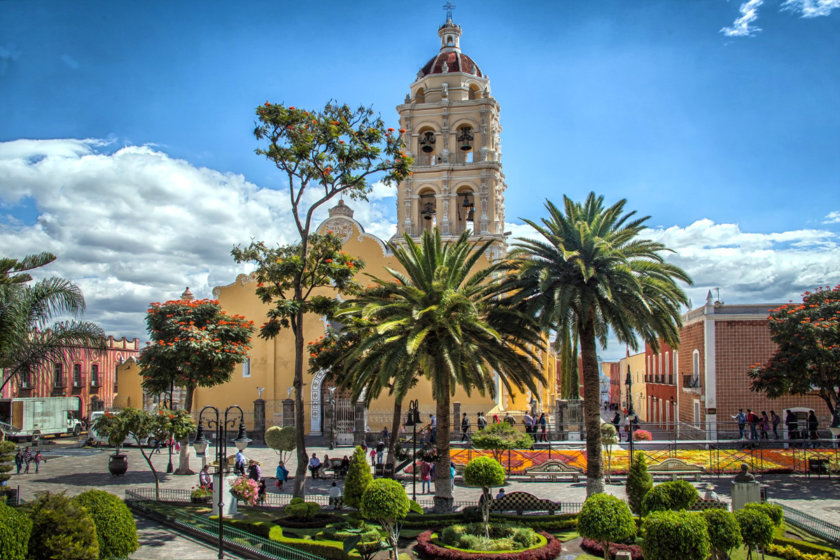
Guadalajara
You shouldn’t miss Calaverandia (October 25th to November 18th), a theme park dedicated to Dia de Muertos!
It features a large offering, music, numerous shows, and interactive games. There are 4 performances that showcase different aspects of Day of the Dead with projections, acrobats, and mariachi music.
There are even trajinera boat rides (traditional vessels), just like in Xochimilco!
You can get your makeup done, bring back a handcrafted souvenir, taste local food (which is affordable!), and there are plenty of spots for great photos. It’s an ideal event for the whole family!
- Sun-Wed-Thu from 7 pm to 12 am, Fri-Sat from 7 pm to 1 am
- Where: Parque Ávila Camacho, Guadalajara
- You can get your tickets here!
Guanajuato City
- Procession of the Little Angels (October 31st, 2023 at 7 pm): from the old train station to Calle del Campanero
- Great Offering (October 31st, 2023 at 9 pm): on the stairs of the University of Guanajuato
- Offering Contest (November 1st, at 2 pm) at Plaza de los Angeles
- Parade of Calaveras and Catrinas (November 1st, 2023, at 8 pm) starting from Jardin de Embajadoras
- Catrine Contest (November 1st, 2023, at 9:30 pm) at Plazuela del Musico
- Tapete de la Muerte (November 2nd, 2023, at 12 pm): traditional sawdust carpets on Sopeña street
- Videomapping (November 3rd and 4th, 2023, at 8:30 pm) at Plaza San Roque
To discover all the activities organized for the Day of the Dead celebration in Guanajuato, I suggest visiting the Guanajuato Tourism Facebook page
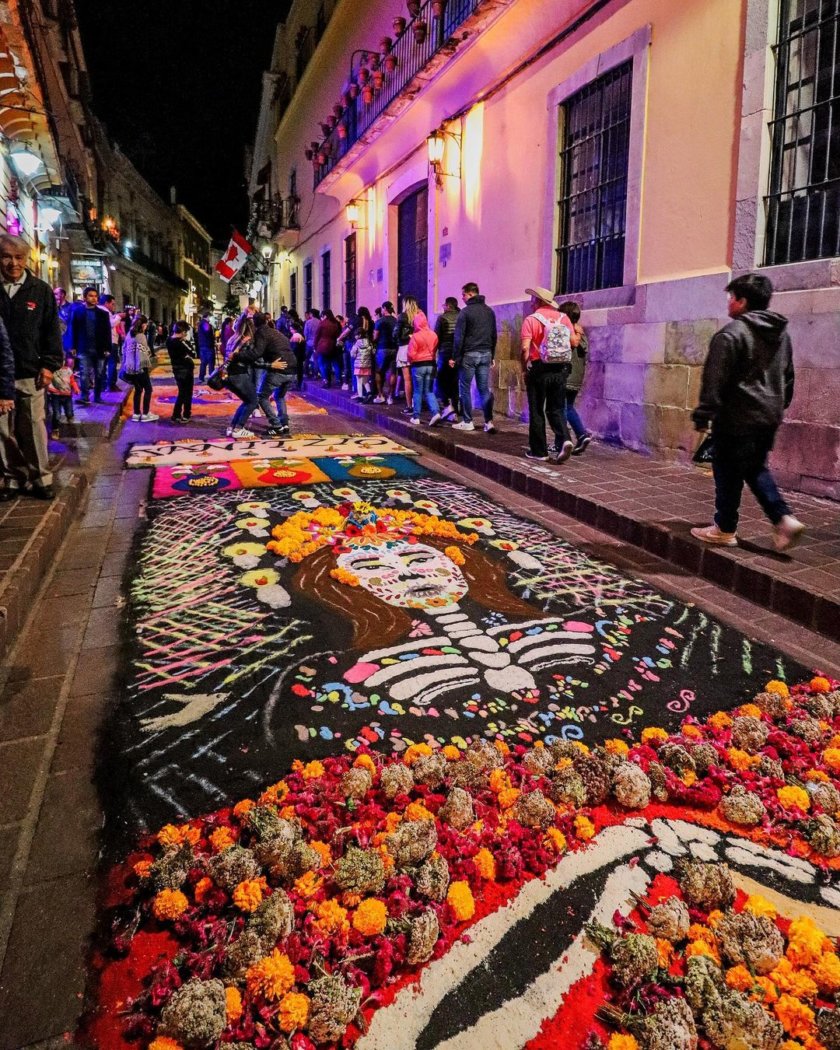
San Miguel de Allende (Guanajuato)
- From October 30th to November 5th, several cultural events: film projection, dances, conferences, theater, concerts, poetry
- On November 2nd at 8 am: installation of the offering at the main Garden and Atrium of the Oratorio Temple
- On November 2nd at 6 pm: Muertos y Catrinas parade, from “El Cardo” to the main Garden
- On November 2nd at 8 pm: Folkloric ballet
To know everything about this charming town, here’s my Ultimate Guide to San Miguel de Allende!
A local guide will show you the must-see places of San Miguel de Allende, with its streets and cemetery adorned with offerings and altars in honor of the Dead. Book your tour here:
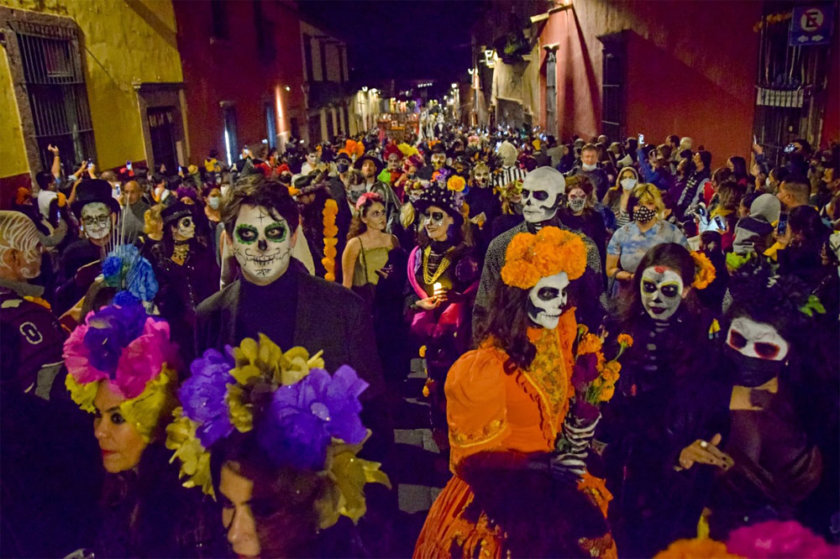
Zacatecas City
- Arch and Facade Decorating Contest (October 30, 2023, at 6 PM), with over 60 historic center locations participating!
- Grand Day of the Dead Parade (October 31, 2023, at 6 PM) in the Historic Center.
- Concert at Plaza de Armas (November 1, 2023, at 8 PM)
- Several other cultural and artistic activities on November 2, 3, and 4.
For all the details, the best thing to do is follow the Zacatecas Tourism Secretariat Facebook Page!
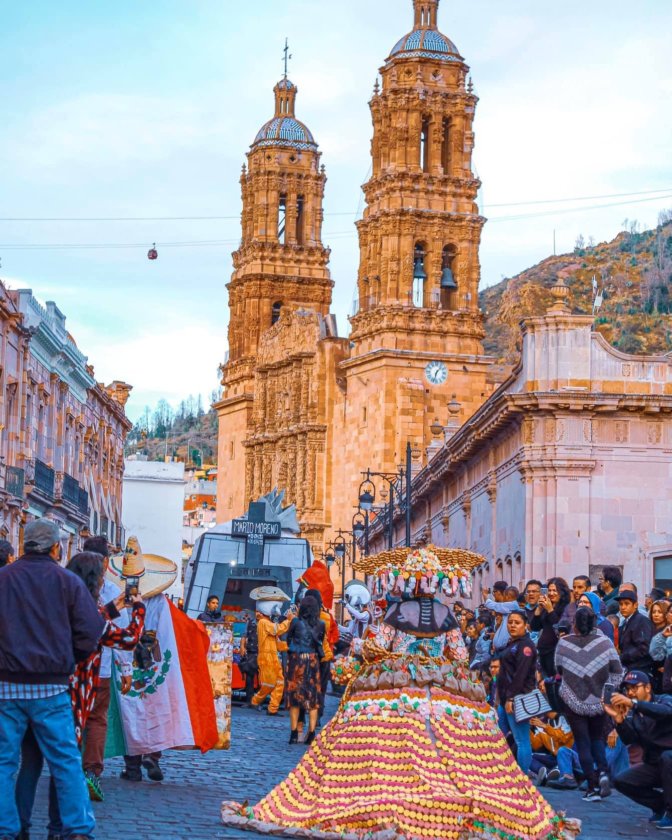
How is the Day of the Dead Celebrated in Mexico?
Every year, numerous Mexican families create at home an altar in honor of their deceased loved ones (more details in the next section!)
Some people also have the custom to visit the cemetery to make offerings and decorate the graves of loved ones with images of saints, candles, cempasúchil flowers, incense, copal, their photographs, and of course, their favorite dishes.
Traditionally, the Dia de Muertos was celebrated in a rather intimate manner.
As the Day of the Dead has gained international fame in recent years, notably due to James Bond films and Coco, new activities have appeared, allowing a broader audience to enjoy the festivities.
What Makes Up the Altar of the Dead in Mexico?
All the elements that comprise it have a great symbolic importance!
It’s important to understand that the altar is designed in a spirit of sharing since the idea is to please the deceased by offering what they loved most (food, drinks, etc.) and to share everything with them when they come to visit their relatives on the night of November 2.
Mexico is a vast country four times the size of France so traditions can vary by region. Still, there are certain fundamental elements found in an altar:
- Photo or photos of the deceased (the altar may be built in honor of one or several individuals)
- Catholic elements such as the cross
- Pretty Cempasúchil flowers, representing the sun and guiding the deceased to the altar with their distinct fragrance
- Candles -purple for mourning or white- whose light helps guide the souls so they can return to their loved ones
- The pan de muerto or “bread of the dead,” which is the typical bread consumed during this festival (in fact, it’s sold throughout October because it’s very popular!)
- Hot chocolate (made with water) to accompany the pan de muerto.
- Colorful little sugar skulls symbolizing the presence of death in human existence.
- Papel picado, which is very common in Mexico. When it moves with the wind, it signifies the arrival of the deceased.
- The food that the deceased loved, including fruits, mole, etc.
- Water representing the purity of the soul. A glass of water may be placed for the deceased to drink after their long journey. Some even place soap and a towel so they can cleanse themselves.
- Salt to keep the soul of the deceased pure during its journey and to ensure its return the following year.
- Incense and copal, a resin burned like incense since pre-Hispanic times, which purifies places
- A figurine of the Izcuintle dog (or Xoloitzcuintle), as a toy when the altar is dedicated to a child. According to traditional pre-Hispanic beliefs, it assists souls in crossing the Chiconauhuapan river to reach Mictlán, the afterlife world
- A floral arch crowning the setup symbolizes the entrance to the world of the dead.
- Alcohol, typically tequila, mezcal or pulque
Some altars are very simple while others are highly elaborate, all depending on the budget each family can invest.
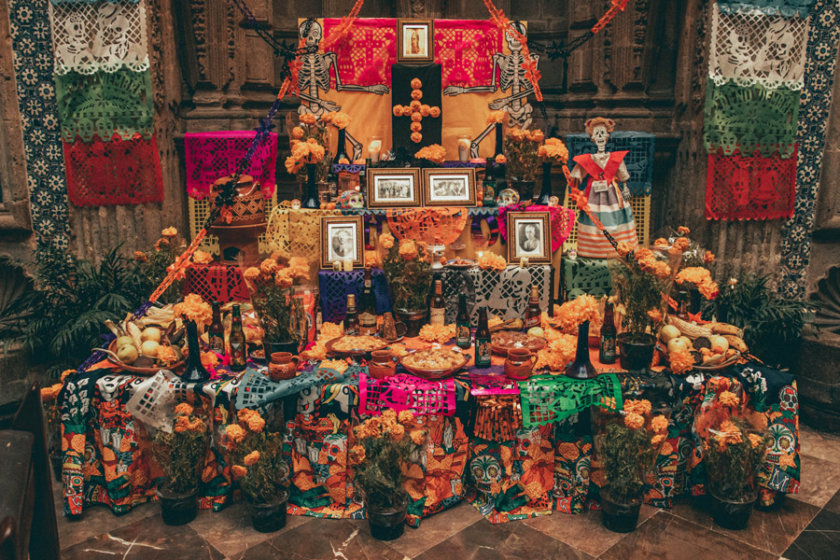
My Last Tips for the Day of the Dead
If you decide to travel to Mexico for the Day of the Dead, here are some important tips to make the most of it:
1. Book Your Hotel in Advance
This period attracts lots of national and international tourists, so I strongly recommend that you book your accommodation in advance, otherwise you’ll end up with less attractive options (poor value for money)!
If you already have your travel dates, you can check out available hotels by clicking on the city that interests you:
- Cancun – You can also check out my Complete Guide to the Best Hotels and Resorts in Cancun!
- Playa del Carmen (Riviera Maya) – Check out my full guide to Playa del Carmen’s top hotels and resorts!
- Mérida (Yucatan) – Explore my ultimate guide to the best hotels in Mérida!
- Oaxaca – Don’t miss my Complete Guide to the Best Hotels in Oaxaca!
- Mexico City – Discover my complete article Where to Stay in Mexico City with great deals for all budgets!
- Patzcuaro (Michoacan)
2. Be Respectful
Though it’s possible to access some cemeteries during the Day of the Dead (e.g. Michoacan, San Andres Mixquic), remember that these sites are primarily places of mourning for families.
You’re welcome to visit, but only if you remain respectful and discreet.
Before taking close-up photos, I suggest you ask for permission from the people. I know it’s much easier not to, but they are neither actors nor objects of curiosity.
Good individual practices help to maintain a positive general impression of visitors. 😉
3. By Car
If you rent a car, expect more traffic than usual (and less parking), so be patient and especially plan your day well to arrive on time (e.g., La Llorona at Xochimilco).
4. Taste Everything!
My most essential tip for the Day of the Dead is: don’t eat before you go because there are many delicious typical dishes to try on-site! 😋
In addition to “pan de muerto” and hot chocolate, you’ll find various moles and tamales, atole, pozole, calabaza en tacha (pumpkin dessert), and more.
Rent a car in Mexico
Renting a car is for sure the best way to explore Mexico and make the most of your stay!
To rent a car, personally, I always use Booking.com Cars, for a few reasons:
- You can easily compare the rental cars prices between all the agencies: for sure the easiest way to find the best rate!
- Cancellation is often offered free of charge: no need to worry if you change your mind
- Booking Cars offers full insurance coverage at a lower price than the rental companies, so it’s an instant saving with no effort
Simply click on the green button to find your rental car at the best price:
How to find your airline tickets at the best price?
To buy your cheap airline tickets, I invite you to use our flight comparator for Mexico, in partnership with Skyscanner: it is the guarantee to pay the best price for your international flight and your domestic flights!
🚗 Rent a car
🗽 Book entrance tickets and guided visits
🏄 Book your sports activities
🌍 Take a travel insurance
🙎 Book a tour
✈️ Book your flight
You’re traveling in Mexico? These articles will help you!
Discover all my articles about Mexico: All my articles to help you plan your trip to Mexico are listed there.
- TOP 35 Things to Do and Must See Attractions in Mexico – All the best places to discover
- Itinerary: 8-10 days in Mexico – From Mexico City to Oaxaca
- Itinerary: 10 days in Mexico – Mexico City, Chiapas and Yucatan
- Itinerary: 2 weeks in Mexico – Best itinerary to discover the Yucatan Peninsula and Chiapas!
- Itinerary: 3 weeks in Mexico – Mexico City, Puebla, Oaxaca, Chiapas, Campeche, Yucatán and Riviera Maya
- Itinerary: 1 month in Mexico – My Epic 30-31 Days Itinerary from Mexico City to Cancun
- Road trip in Mexico: The best itineraries for 10, 15, 21 days and a month
- Itinerary: 1 week in Yucatan – The Ultimate 6, 7 or 8 days Itinerary
- Itinerary: 10 days in Yucatan – Best Itinerary for 9, 10 or 11 Days in Yucatan
- Itinerary: 2 weeks in Yucatan – Epic Itinerary + All my Best Tips!
- Itinerary: 3 weeks in Yucatan – Best things to do in 20-21 days
- Itinerary: 1 month in Yucatan – Yucatan Peninsula in 29, 30 or 31 days from Cancun
- Road trip in Yucatan: The best itineraries for 7, 10, 15, 21 days and 1 month
You’re using Pinterest? Here is the picture to pin!
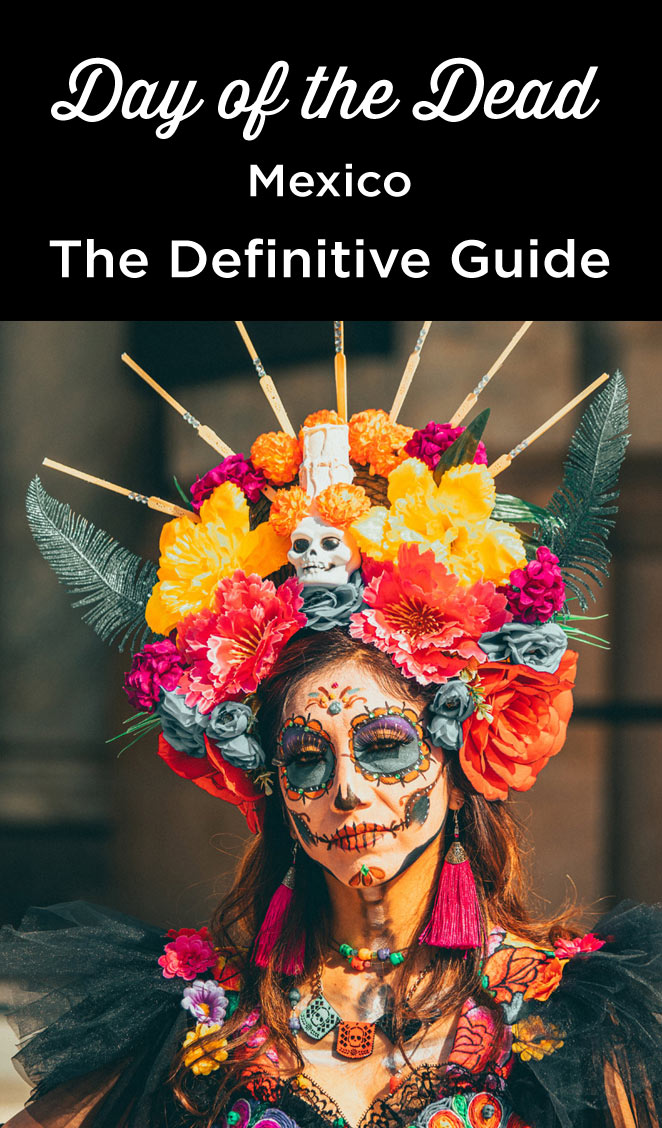





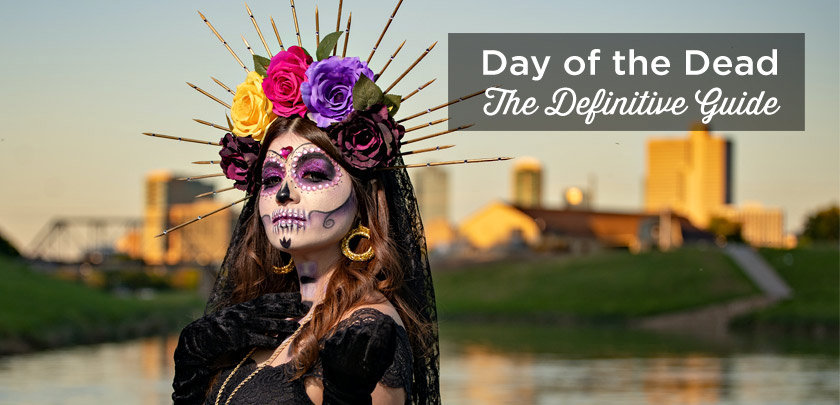

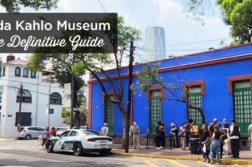

Discussion2 Comments
¡Hola!
¿Qué opinas del Hanal Pixan en Valladolid? dicen que es muy bonito y quizás más sentido.
Hola Tania! La verdad es que yo nunca he asistido a Hanal Pixan en Valladolid, pero como la ciudad es más pequeña que Mérida, y tiene mucho encanto en cualquier época del año, debe ser bien bonito e interesante!